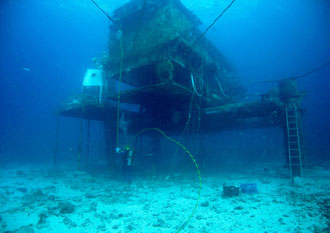| Surgery, information technology | |||
NASA undersea mission to test space medicine11 March 2007 Washington, USA. The NASA Extreme Environment Mission Operations (NEEMO) scheduled for May this year will include a variety of advanced medical technology experiments, including robotic telesurgery on simulated patients. Scientists and school children also will be able to move two remotely controlled surgical robots in the underwater laboratory. The NASA Extreme Environment Mission Operations 12 (NEEMO 12)NASA will send a flight surgeon, two astronauts and a Cincinnati doctor into the ocean depths off the Florida coast May 7-18 to test space medicine concepts and moon-walking techniques. It is the first undersea mission to include a NASA flight surgeon.
NASA Flight Surgeon Josef Schmid, NASA Astronaut Jose Hernandez and Dr Tim Broderick of the University of Cincinnati will be in the crew. Veteran space flyer Heidemarie Stefanyshyn-Piper will lead the 12-day undersea mission aboard the National Oceanic and Atmospheric Administration (NOAA) Aquarius Underwater Laboratory. "Schmid's unique experience in space medicine will benefit the mission itself as well as the future development of crew care techniques for long-duration human spaceflight missions," said NEEMO Project Manager Bill Todd of NASA's Johnson Space Center in Houston. Hands-on telesurgery demonstrations and robotic telesurgery technology developed and refined within this mission will help surgeons overcome interplanetary communication lag time. Technologies such as surgeon-guided automatic robot function could improve the care of astronauts on future missions to the moon and Mars. The crew will conduct simulated undersea "moon walks" to test concepts for future lunar exploration. During these simulated moon walks, they will construct an undersea structure with the help of a remotely operated vehicle, similar to what the next travellers to the moon may do. The crew also will practice collecting geological samples to help develop tools and techniques for collecting lunar samples as well as train future lunar explorers to be geologists. James Talacek and Dominic Landucci of the University of North Carolina at Wilmington will provide engineering support for the submerged Aquarius habitat. The University of North Carolina at Wilmington operates Aquarius on behalf of NOAA as part of NOAA's Undersea Research Program. The NEEMO missions are a cooperative project among NASA, NOAA and the university. This will be the 12th NEEMO undersea mission. NASA Astronaut Richard Arnold and NASA Flight Surgeon Sean Roden will serve as backup crew members. It is the second NEEMO mission including the University of Cincinnati and Broderick as a crew member; the first, NEEMO 9, took place in April 2006. Similar in size to the International Space Station's living quarters, Aquarius is the world's only permanent underwater habitat and laboratory. The 45-foot long, 13-foot diameter complex is three miles off Key Largo in the Florida Keys National Marine Sanctuary, about 62 feet beneath the surface. A surface buoy provides connections for power, life support and communications. A shore-based control centre monitors the habitat and crew. For more information about the NEEMO 12 crew, its
mission and Aquarius, visit:
|
